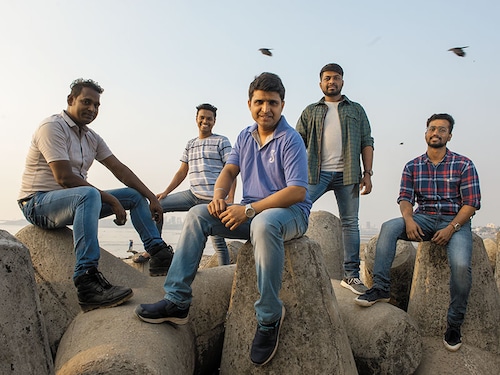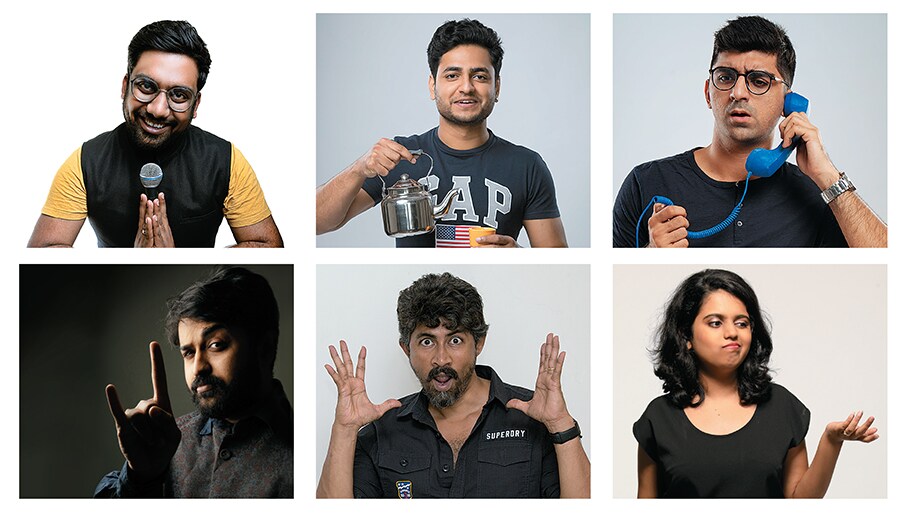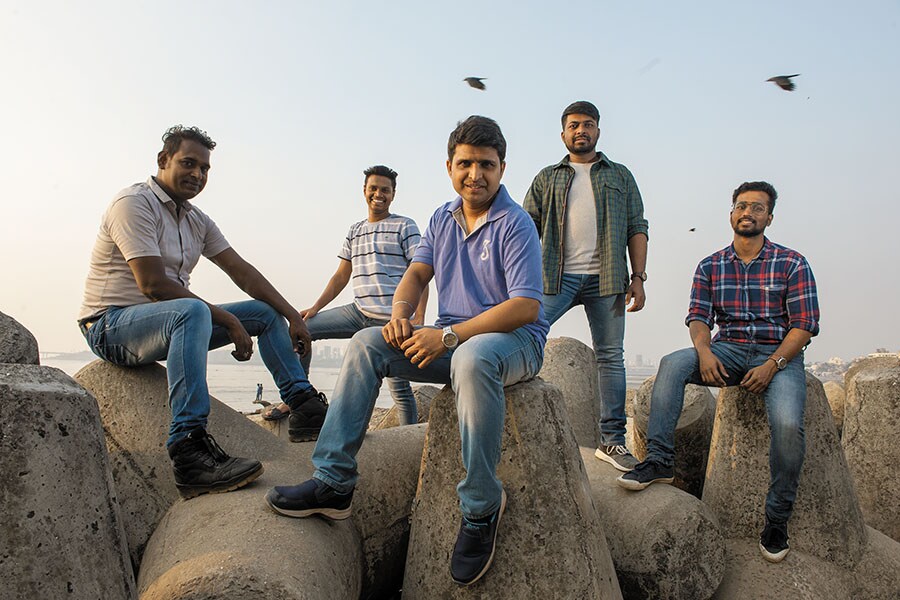Standup comedy 2.0: In Tamil, Gujarati, Marathi
Standup comedy is moving to regional languages and OTT platforms to expand its reach


 (Clockwise from top left) Manan Desai, Kenny Sebastian, Raunaq Rajani, Aishwarya Mohanraj, Karthik Kumar and Anup Maiya
(Clockwise from top left) Manan Desai, Kenny Sebastian, Raunaq Rajani, Aishwarya Mohanraj, Karthik Kumar and Anup Maiya
Image:- Manan: Mohit Budania Karthik: P.Ravikumar For Forbes India Anup: Selvaprakash Lakshmanan For Forbes India [br]In his career as a radio jockey, Manan Desai had it all: A dream job, the popularity and decent money. Yet he felt something was missing. This was 2010-11, when Russell Peters’s standup comedy videos were growing popular among Indians. In August 2011, at the Offside Lounge in Vadodara, Desai finally decided to try his luck at standup comedy. His first untrained 60-minute act bombed, but Desai realised the missing element from his almost perfect job: Being a ‘performer’.
“There was a dearth of live entertainment in Gujarat. It is a dry state, which is why live entertainment never saw the light of day here. We saw an opportunity in this space,” says Desai. In 2011, he and his wife Vidya decided to set up The Comedy Factory to help formalise Gujarati standup comedy. At the time, there were barely any platforms for standup comedians, the Canvas Laugh Club being one of the few in the country. Even on those platforms, English-speaking comedians like Vir Das, Gursimran Khamba and Rohan Joshi were the ones drawing in the audience.
With The Comedy Factory, the Desais wanted to bring back comedy as an art form in their native language. “I have this love for my language and culture. And I strongly believe that Gujaratis were so busy earning money that we forgot to nurture our arts and culture,” says Desai.
The group, which now has six core members, not only does live shows and YouTube sketches, but also organises live productions across Gujarat and handles other Gujarati standup comedians. It started touring internationally two years ago and has done about 60 shows across the world. And with OTT platforms now gaining steam, The Comedy Factory has turned towards them to expand reach. “With OTT platforms, we already have two shows on the floor and one, a 13-episode series, is at the post-production stage,” says Desai.
*****
Mumbai-based talent management company Only Much Louder (OML) was the first organisation to bet on standup comedy in India. The first time OML got a whiff of the potential of standup comedy had was when AIB was going on its first tour, The Royal Turds, in 2013, recollects Gunjan Arya, CEO of OML. “They [AIB] reached out to us to help them organise the tour. And when we saw the turnout, we realised the potential,” says Arya. On the back of this, the whole content practice at OML began when they started working with the likes of Kenny Sebastian, Abish Mathew and Kanan Gill, who were growing popular on YouTube. “There were barely any venues for comedians to do standup then. But with their growing popularity, we realised there was so much appetite for comedy.” Today, OML is one of the largest players in the comedy space, and in 2019 their artistes performed in over 80 cities in India and over 50 across the world.
Like OML, Chennai-based Evam Standup Tamasha is one of the largest enterprises that tried to organise the standup comedy industry in South India. Evam started out as a theatre-based company in 2003 and it was only in 2009 that it began doing autobiographical monologues in comedy, later called standup comedy. “This was a time when we had no reference, which worked well for us because we could be original with our ideas. And YouTube gave us a platform to reach out to a lot more like-minded people, which eventually converted to ticket sales,” says Karthik Kumar, founder, Evam, which manages about 16 Tamil and ‘Tanglish’ comedians. Local flavour: (from left) Marathi comedians Vilas Panchal, Tejas Jaywant, CEO of Café Marathi Nikhil Raibole, and comedians Sachin Bhilare and Akshay Kokane
Local flavour: (from left) Marathi comedians Vilas Panchal, Tejas Jaywant, CEO of Café Marathi Nikhil Raibole, and comedians Sachin Bhilare and Akshay Kokane
Image: Mexy Xavier[br]About three months ago, Evam opened SoCo (South Of Comedy), a venue exclusively for standup comedy performances in Chennai’s Savera Hotel. “When it comes to comedy, our approach has been simple: Being relevant and relatable. We started discussing not just funny instances, but also personal topics, social and political issues as well as sexual issues,” says Kumar.
About three years ago, Nikhil Raibole noticed a dearth of good Marathi content, so he quit his full-time job in advertising and decided to set up Café Marathi. However, it was only about a year and a half ago, when Raibole and his team started getting queries from across Maharashtra about comedy content. Ever since, the team has been working on getting the right venues and organising open mic nights for Marathi standup comedians. “The biggest challenge was creating acceptability for Marathi comedy—subtle, unlike the loud comedy people were used to—both for the audiences as well as the comics,” says Raibole, the founder and CEO of Café Marathi, which currently manages 20 Marathi comedians.
While they followed the conventional path of organising open mic nights and producing sketches for YouTube, the platform decided to set up a competition, Cafe Marathi Comedy Champ, earlier in 2019. “In the first two days, we got 150 entries and not just from Mumbai and Pune, but across Maharashtra. We tied up with Hungama Play to stream the competition for a wider audience to view it. It was a hit. We are planning a second season in early 2020,” says Raibole.
But although the demand for Marathi comedy is growing, there are few Marathi comedians who have taken to the profession full-time. “People have started thinking about taking it more seriously now, but till the time they don’t have a regular income from it, it will be very difficult,” he says. While a show like Comicstaan Marathi would be great, Marathi comedy is still at a nascent stage for them to create a full-blown show, he adds.
Raibole isn’t the only one. Anup Maiya, founder of Lolbagh, a comedy collective, feels the same way about Kannada standup as well. Three years ago, when Maiya—founder of an online teaching platform Kannadagottilla.com—was exploring the space, he realised there were senior comedians doing standup that focussed mostly on literature and on an audience aged from 50 to 60 years. He organised a couple of open mic nights for a younger audience and met the core team of Lolbagh, but even now the team of seven is sceptical about taking up standup comedy full-time.
“There is a comedian who’ll quit his full time job and take this up starting January. The sector is opening up slowly because of the revenue being generated through corporate, live shows and also through YouTube with branding,” says Maiya.
*****
Kenny Sebastian, among the most popular standup comedians, has a key takeaway from his 19-year-old self while cracking the standup code. Back then, he would shoot, edit and upload his own videos on YouTube. “People forget it’s not standup that’s doing well, it’s YouTube. So if you are a standup comedian that does not put content out, you will not do well. No comedian in the world is successful by just doing standup.”
“Putting yourself out there” has become a tad bit easier now as, along with YouTube, OTT platforms are giving a leg up to younger talent with shows like Comicstaan. It is on OTT platforms that most expect the future of comedy to reside. Standup specials have proven to be a great driver for audiences to subscribe to platforms like Amazon Prime and Netflix, and have brought in visibility for aspiring comedians in return.
Aishwarya Mohanraj, a 23-year-old analyst with Nielsen, performed at an open mic on her birthday two years ago. And she was terrible. “I realised I loved being on the stage for all of those 4 minutes, when the whole audience is listening to you. I knew I was going to go back and do this again,” recollects Mohanraj. Three months later, she received an email about auditions for Comicstaan. But when she got through, it was time to take the tough call: It was either her full-time job or Comicstaan. While she quit her job and took the plunge, Mohanraj also generously acknowledges that knowing she had a back-up plan, her degree and the promise of a lucrative job if she failed, propelled her to take the risk.
“Traditionally, world over, when it comes to marketing, the spends are moving towards digital and it is becoming more of an influencer-led or creator-led content space,” says Dhruv Sheth, COO, OML. He adds that there are three major revenue streams for a standup comedian today. “One is live shows, the second is creating content for brands and the last one, which is also the biggest chunk of their earnings right now, is from OTT platforms.” OML is organising a week-long Comedy Fest in March 2020, which will showcase English, Hindi, regional as well as international artistes.
Sheth adds, “Comicstaan was literally a bet, since we didn’t know what kind of talent was going to come, if it was going to work at all.” When creating the concept, the team wanted participants to break the monotony of regular reality TV shows, filled with drama. “We wanted the show to be authentic to comedy, and that’s why we divided the show by genres and not by themes.” The show was framed in a way that most of the younger talent got to learn from mentors, which helped create a sense of community among the comedians.
Raunaq Rajani, who had a great affinity for stand-up comedy since 16 but had no plans to take it up professionally, quit working for his father at 22 and took up a job as a writer for East India Comedy. The going was tough, though, till Comicstaan happened to him. “While I had done a bunch of YouTube videos, what really worked for me was OTT. Because there was a lot more traction that came my way after the show,” says Rajani.
Maiya also believes the biggest push to generating revenues will come when Amazon and Netflix give them a platform to showcase their work. However, a year ago, Lolbagh did a show for Voot called Comediga, it didn’t do as well as they expected. “The biggest challenge is restrictions on content. People get very uncomfortable when we talk about adult content. And we are forced not to talk about politics and filmstars the regional audience is a lot more sensitive,” says Maiya, who has stopped performing and focuses on managing artistes and organising events for Lolbagh. The team has gone for international tours across Germany and Australia earlier this year.
Besides, while Comicstaan gives fresh talent a great platform, they are a long way from bagging brand-related deals for YouTube or specials on OTT platforms. And they can’t survive merely on live shows. “A lot of the established talent give opportunities to younger comedians while they are writing specials or shows, like a Pushpavalli, or even when they are creating brand-related sketches. Not only does it benefit them monetarily, but also helps them get the right experience,” says Sheth.
The OTT platforms are also trying to give regional standup artistes a push, with Comicstaan launching a Tamil version. Kumar of Evam says, “It will be a huge turning point in just activating regional standup comedy in a significant way, both in terms of finding new talent and helping them with the right kind of monetary gains.”
But Desai of Comedy Factory believes OTT needs to see numbers before they can bet on regional languages. “Although there is a lot of potential, we also have to prove a lot before they trust us with bigger and better projects, so it will take some time…”
Kumar believes regional comedy will soon be doing shows on the lines of Last Week Tonight with John Oliver. And, of course, breaking stereotypes, like passing off the Tamil accent as just another joke. Says Kumar: “A comedian is not somebody who makes you laugh, he or she is someone who makes you think through the laughter.”
First Published: Dec 24, 2019, 14:39
Subscribe Now